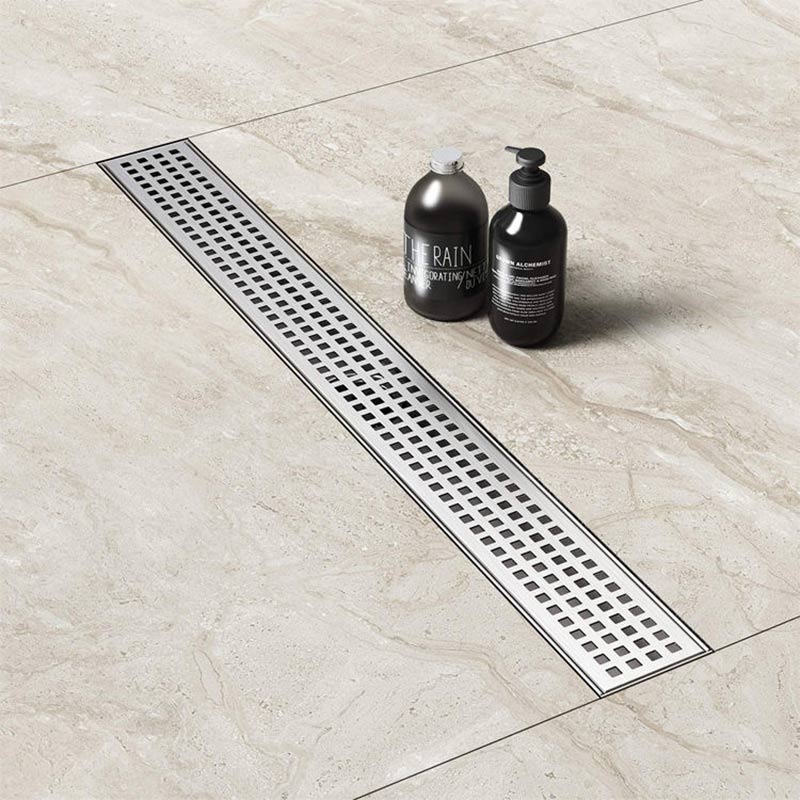How Does A Shower Drain Work?
Every shower system depends on an efficient drainage design to remove used water quickly and hygienically. While it seems simple—a few drops flow into a hole and disappear—the Shower Drain is actually a highly engineered component designed to manage large volumes of water safely, prevent odor backflow, and maintain long-term plumbing stability.
Understanding how a shower drain works helps homeowners, plumbers, and designers make better choices for installation, maintenance, and bathroom safety. This article explains what a shower drain is, how it works, and why its design is essential for every bathroom, whether in residential or commercial projects.
1. What Is a Shower Drain?
A shower drain is a plumbing fixture that collects wastewater from the shower area and directs it to the household drainage or sewer system. It acts as the link between your shower floor and the main drainage line beneath the bathroom.
Most shower drains consist of four key components:
Drain Cover or Grate: The visible metal or plastic top that filters hair and debris.
Drain Body: The hidden chamber beneath the shower floor that connects the surface water to the plumbing line.
P-Trap (or S-Trap): A curved section of pipe that holds water to block foul odors from rising.
Drain Pipe Connection: The extension that leads wastewater into the home’s main drainage network.
Common Types of Shower Drains
Point Drain: Typically round or square, positioned at the lowest point of a sloped shower floor.
Linear Drain: A long rectangular design often installed along one edge of the shower, popular in modern bathrooms for aesthetics and accessibility.
Hidden or Tile-In Drain: The top surface is tiled to match the shower floor, giving a seamless look.
Regardless of the shape, the fundamental function of all drains remains the same—to efficiently remove water and prevent leaks or odors.
2. The Basic Working Principle of a Shower Drain
A shower drain functions based on gravity and fluid dynamics. When you take a shower, water flows toward the drain opening due to the slope of the shower floor, typically 1–2% (around 2 cm drop per meter). Once it enters the drain, it passes through several internal parts before reaching the sewer line.
Here’s a simplified step-by-step explanation of how it works:
Water Collection:
Water from the shower floor enters through the drain cover openings.Filtration:
The cover or grate catches larger debris like hair or soap particles to prevent pipe blockage.Flow Control Through the Drain Body:
Beneath the cover, the water passes into the drain body, a funnel-shaped cavity that directs flow downward into the waste pipe.Odor Prevention via P-Trap:
The P-trap, a U-shaped pipe filled with water, acts as a seal. It prevents sewer gases and unpleasant smells from escaping into the bathroom.Discharge to Sewer Line:
The wastewater then moves through the drainpipe under gravity and connects to the main house sewer system.Ventilation:
Plumbing vents allow air to flow into the pipes, maintaining pressure balance. Without venting, slow drainage or gurgling sounds may occur.
This process repeats every time the shower is used—simple in appearance, but dependent on precise engineering and slope design.
3. The Role of the P-Trap and Water Seal
The P-trap is the most critical part of the shower drain system. Its curved shape holds a small amount of standing water even after the shower is turned off. This water acts as a barrier between the bathroom and the sewer system.
Why It’s Important
Prevents Odors: Sewer gases, such as methane and hydrogen sulfide, cannot pass through the water barrier.
Stops Insects: Keeps drain flies or cockroaches from entering through pipes.
Maintains Air Pressure: Stabilizes the flow of water by reducing suction and turbulence.
If the P-trap dries out (for instance, when a shower isn’t used for several weeks), unpleasant smells may emerge. Regularly running water for a few seconds keeps the trap filled and functional.
4. Water Flow Design: Gravity and Slope
The success of a shower drain depends heavily on proper slope design. Water moves naturally from higher to lower points, so the floor must be slightly inclined toward the drain.
Recommended Slope:
1–2% gradient (around 1/4 inch per foot or 2 cm per meter).
The slope ensures no stagnant water and reduces bacterial growth or mold.
In linear drains, the slope runs in one direction, while in point drains, it radiates from all sides. Proper slope prevents pooling, especially in tiled showers where grout lines can trap moisture.
Poor slope design or installation errors can lead to:
Standing water or puddles.
Slow drainage.
Mold and mildew buildup.
Premature damage to flooring materials.
Hence, the drain’s performance begins with the right construction technique during installation.
5. Materials and Construction
Shower drains are made from various materials, depending on their environment, budget, and required durability.
Common Materials
| Material | Features | Typical Use |
|---|---|---|
| Stainless Steel | Rust-resistant, durable, modern finish | Premium residential or commercial bathrooms |
| PVC (Plastic) | Lightweight, easy to install, affordable | Standard residential systems |
| Brass | Corrosion-resistant, traditional style | Vintage or high-end designs |
| ABS Plastic | Tough, heat-resistant | Hot water systems or frequent use environments |
| Zinc Alloy / Aluminum | Budget-friendly, decorative finishes | Basic home renovation projects |
Modern stainless steel drains are especially popular because they combine corrosion resistance with aesthetic appeal. Many feature anti-blockage grids and removable traps for easy maintenance.
6. Modern Innovations in Shower Drain Design
Today’s bathrooms prioritize not only function but also cleanliness, aesthetics, and accessibility. Modern shower drains incorporate technologies and design improvements to meet these needs.
1. Linear Drain Systems
These create a sleek, barrier-free appearance. Because they only need a one-way slope, they’re ideal for walk-in showers and universal design bathrooms.
2. Removable Traps and Filters
Advanced models include built-in hair catchers and anti-clog inserts that can be easily removed and cleaned without tools.
3. Anti-Odor and Self-Sealing Drains
New designs use silicone membranes or mechanical seals that automatically close when dry, preventing odors even if the P-trap loses water.
4. Waterproof and Leak-Proof Systems
Integrated sealing flanges and rubber gaskets ensure no leakage occurs around the drain edges, protecting subfloor structures from water damage.
5. Customizable Covers
Grates now come in stainless steel, brushed nickel, matte black, or tile-in designs for seamless integration with bathroom décor.
7. Common Problems and How to Maintain a Shower Drain
Even the best shower drain needs regular care to perform efficiently. Most drainage issues arise from blockages, improper installation, or lack of cleaning.
Common Issues
Slow Drainage:
Usually caused by hair, soap residue, or limescale buildup in the pipe or trap.Unpleasant Odors:
Often due to a dry P-trap or bacteria thriving in stagnant water.Leaks Around the Drain:
Poor sealing during installation or cracked grout can cause water to seep under tiles.Noise or Gurgling:
Indicates improper venting or air blockage in the drain line.
Maintenance Tips
Clean the Drain Cover Weekly: Remove hair or soap buildup with a brush.
Use Baking Soda and Vinegar: Pour half a cup of each into the drain monthly, followed by hot water after 10 minutes to dissolve organic residue.
Check for Leaks: Look for damp spots around tiles or flooring.
Maintain Water Seal: Run water occasionally in unused showers to refill the P-trap.
Avoid Chemical Cleaners: Harsh products may corrode pipes or seals; enzyme-based cleaners are safer.
Regular maintenance not only keeps your shower drain odor-free but also prolongs the lifespan of the entire plumbing system.
8. The Importance of Quality Drain Installation
Proper installation is just as crucial as product quality. A well-designed drain will fail if installed incorrectly. During construction or renovation, professionals follow specific steps to ensure long-term performance:
Accurate Floor Slope Formation: The foundation must direct water naturally toward the drain.
Waterproof Layer Protection: Applying a waterproof membrane beneath the tiles prevents leakage into subflooring.
Correct Pipe Connection: Sealing joints with silicone or PVC cement ensures no water escapes.
Testing Before Finishing: A water leak test should be performed before laying final tiles.
Appropriate Material Choice: Stainless steel or ABS is recommended for bathrooms with heavy moisture exposure.
Choosing reliable manufacturers and certified plumbers ensures the drain functions efficiently for years, without unexpected maintenance or odor issues.
Final Thoughts
A shower drain might be a small detail, but it’s the backbone of every bathroom’s hygiene and comfort. It works through simple physics—gravity and water seals—but its effectiveness depends on precise installation, quality materials, and ongoing maintenance.
From collecting wastewater to preventing odor and ensuring leak-free operation, every component plays a vital role. Modern designs, like linear or self-sealing drains, have further improved both performance and appearance, reflecting how functional design can also be beautiful.
Whether you’re building a new bathroom or renovating an existing one, understanding how a shower drain works helps you make smarter decisions—ensuring your shower area remains clean, efficient, and worry-free for years to come.




